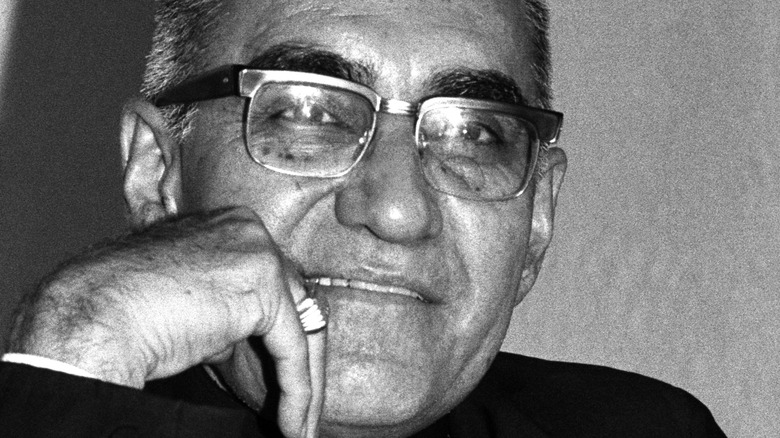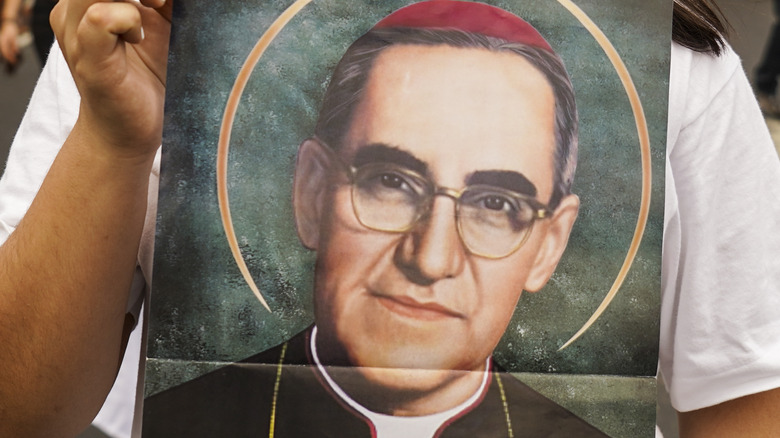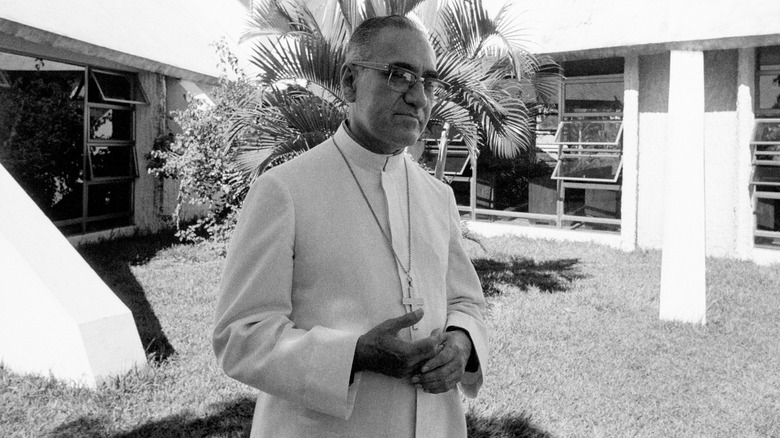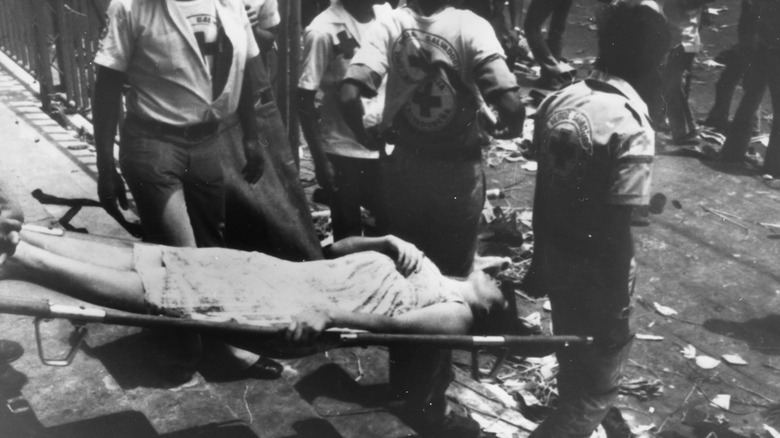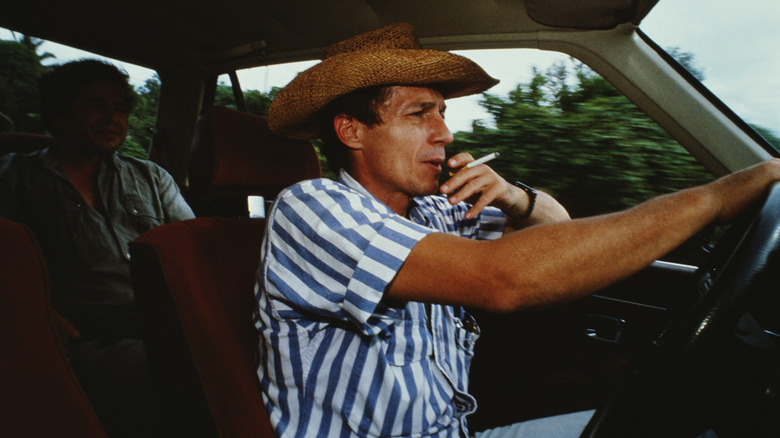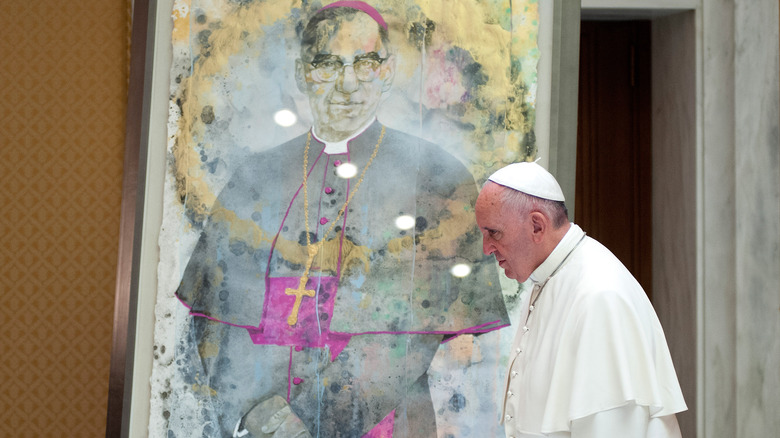The Tragic Story Of The Massacre At St. Oscar Romero's Funeral
It was sunny, but already getting hot, on the morning of March 30, 1980, as a contingent of 30 bishops from around the world and 250 priests walked toward San Salvador's cathedral. They were there, in El Salvador's capital that morning, to pay tribute to one of their own, Archbishop Óscar Romero, who had been murdered a week earlier, according to Father James L. Connor, in attendance that day from Washington, D.C. (writing in America Magazine). A crowd of nearly 250,000 gathered at the plaza in front of the cathedral to honor their beloved archbishop who fought for the poor in a country ruled by a right-wing military-civilian junta backed by the United States, per The Irish Times.
The event started off peacefully with hymns, Bible scriptures, and prayers before Cardinal Ernesto Corripio Ahumada, a member of the Mexican clergy and the personal representative of Pope (now Saint) John Paul II, began his speech in which he praised Romero as "a man of peace and a foe of violence," according to Father Connor.
Who was Saint Óscar Romero?
Archbishop Óscar Arnulfo Romero, the man they had come to mourn and celebrate that tragic day, hadn't always been a vocal advocate for El Salvador's poor, according to Britannica. Born in 1917 in Ciudad Barrios, El Salvador, he was trained as a carpenter before being called to the priesthood. Romero was considered a conservative until being appointed bishop to rural Santiago de Maria, where he got a first-hand view of how the country's poor suffered under the brutal dictatorship of General Carlos Romero (no relation). Less than a month after Óscar Romero's appointment as archbishop of San Salvador, government security forces murdered his friend, the Jesuit priest Father Rutilio Grande, solidifying Romero's position against the dictatorship, per The Irish Times.
In 1979, a military junta overthrew the dictatorship, and Romero, as he had done with the previous government, refused to kowtow to them. He publicly called out the U.S. government for backing the junta, per Franciscan Media. Romero also condemned the violence perpetrated by left-wing guerrillas who rose up against the junta, and attempted to seek a peaceful resolution to the country's problems.
The Assassination of Saint Óscar Romero
By the spring of 1980, Archbishop Romero was internationally known and had been nominated for the Nobel Peace Prize, per Britannica. In El Salvador, his weekly sermons were broadcast across the country and he continued to speak out against the death squads murdering anyone the government deemed a threat. The evening before his own murder, Romero publicly pleaded with the country's soldiers and police officers to stop the killing, telling them, "no soldier is obliged to obey an order counter to the law of God," according to Franciscan Media. "In the name of God, in the name of this suffering people whose cries rise to Heaven more loudly each day, I implore you, I beg you, I order you in the name of God: Stop the repression!" Romero said, per The New Yorker.
On March 24, as Romero presided at Mass at San Salvador's Church of the Divine Providence, a car pulled up out front, a man got out, steadied his rifle against the car's door, and squeezed off a single shot, according to The Guardian. Romero — standing behind the altar, leading the central act of Catholic worship — fell to the ground, shot in the heart, and died a few minutes later, per The Irish Times.
An international outcry followed Archbishop Romero's murder. The U.S. government promised to get to the bottom of it, but in reality did nothing, per The Guardian. Pope John Paul II condemned the killing, calling it "sacrilegious" and "an attack on man in the cruelest manner," according to an Associated Press story from the time.
International Church dignitaries attended Archbishop Romero's funeral
A week later, bishops from across Central and South America, Ireland, England, Spain, Canada, and three from the U.S., arrived in San Salvador for Archbishop Romero's funeral, per America Magazine. Among them was Archbishop John Quinn, the archbishop of San Francisco. According to his account published in the National Catholic Reporter in 1980, as the sermon began, suddenly a bomb went off near the National Palace, a government building. Then gunshots rang out and pandemonium reigned as the frightened crowd scattered amid more explosions, gunfire, and screaming, Father Connor recalled. Up to 50 people, who had simply wanted to pay their respects to a murdered church leader, themselves died either from gunshot wounds or from being trampled in the stampede, per The Irish Times.
When the bombs began going off and the shooting started, Archbishop Quinn was pushed into the cathedral by the thousands of people fleeing for safety who nearly trampled him in their mad rush. Inside the building, nearly 6,000 people packed in together so tightly that children and older people could hardly breathe. Many people passed out in the sweltering heat, and Archbishop Quinn, fearing the worst, gave general absolution to all there, in case they died. Nearly three hours later, he stumbled out of the cathedral, drenched in sweat, and into the plaza strewn with dead bodies, Quinn recalled.
No one pays for the massacre, nor for Romero's murder
The government of El Salvador reported there had only been a "slight disturbance" during Archbishop Romero's funeral and blamed the violence on members of left-wing organizations who had attended the funeral, according to the National Catholic Reporter. Archbishop Quinn repudiated these reports, writing that the left-wing organizations had been peaceful. Archbishop Quinn, along with Father Connor, believed government forces were to blame for the bloodshed at the funeral. Father Connor wrote in America Magazine that eyewitnesses saw a bomb thrown into the crowd from the National Palace, a government building with strict access, and that "people had seen shots fired from the National Palace at the leftists, not by them." Father Connor and 22 other church representatives put out a statement (via the Diocese of Hamilton, Ontario) that very day to tell the world the truth about the massacre in which they called the government's version of events a "distortion of the facts"' and "a false interpretation" of what happened.
No one was ever charged with these crimes. Similarly, Archbishop Romero's killer was never brought to justice. In 1992, a United Nations-backed "Truth Commission" investigated Archbishop Romero's murder and determined Roberto d'Aubuisson, a former National Guard major, acting under government orders, headed up the death squad that murdered Romero, per The New Yorker. More than a decade earlier, the U.S. government buried the truth about the archbishop's murder in order to maintain its dirty war in El Salvador, according to The Guardian.
Archbishop Romero is declared a saint
After Archbishop Romero was buried beneath the cathedral where the massacre occurred, the site became a place of pilgrimage for Catholics. Pope John Paul II visited Archbishop Romero's tomb, in 1983 and again in 1996, according to The Irish Times. The next year, he declared the archbishop a Servant of God, the first step toward canonization, per The Irish Times. In 2015, Pope Francis declared Archbishop Romero a martyr, fast-tracking him for sainthood, with only one miracle needed to make it happen, per the National Catholic Reporter. The wife of a Salvadoran man slipped into a coma while giving birth. The husband prayed for Archbishop Romero's intercession and she recovered. The Vatican accepted this as a miracle and Archbishop Romero was canonized St. Óscar Romero in 2018.
Because of St. Óscar, neither the massacre at his funeral nor U.S. involvement in El Salvador, especially Washington's role in supporting the junta that murdered the archbishop and thousands of others, will be forgotten. The 12-year Civil War ripped the country apart and led to the deaths of 75,000 civilians, many of them murdered by government death squads trained by the U.S., per The Atlantic.
